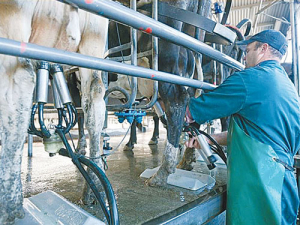Calf rearers say goodbye to leaky teats, poor feeder fit
Leaky teats and poor feeder fit are now a thing of the past for calf rearers - thanks to the Thriver range of calf teats from Skellerup.
 Halving bulk milk somatic cell counts from 300,000 to 150,000 is estimated to increase total season milksolids by 2.1%.
Halving bulk milk somatic cell counts from 300,000 to 150,000 is estimated to increase total season milksolids by 2.1%.
Filling the vat with the best milk you can produce is a financial advantage, says milking liner maker Skellerup.
Studies have shown hefty production gains from maintaining good milk quality, the company says. For example, halving bulk milk somatic cell counts (BMSCC) from 300,000 to 150,000 is estimated to increase total season milksolids by 2.1%
In general, the lower your somatic cell count (SCC) and the fewer grades incurred during lactation, the more efficient and thorough is your milking process.
Attention to detail and a preventative approach go a long way towards improving milk quality, and this is the ideal time of year to review your system, says Skellerup. A key question to ask is: when did we last replace the liners?
Milking liners are the one item in direct contact with the cow. During each lactation she typically spends 50-100 hours attached to the machine, via those liners.
“Milking liners are hidden inside the shells, so you can’t see what happens to them when they wear out,” says Skellerup national manager Perry Davis.
“The first thing you might see instead is a cow kicking the cluster off, damaged teat ends or a surprisingly high BSCC on the milk docket.”
Worn, poor-fitting liners can leave milk in the udder, slip off the teat and/or leave permanent rings at the top of the teat. And any internal cracks in the rubber are an ideal environment for bacteria.
Skellerup offers an easy way to check if milking liners are due for replacement: go to www.2500change.co.nz and fill in the required fields or use a calculator to work out how many times they’ve been used since they were installed.
If it’s 2500 or more, it’s time to change, Davis says.
Last month's Agritechnica event led to a wide group of manufacturers celebrating successes when the 2026 Tractor of the Year Competition winners, selected by a panel of European journalists, were announced in Hanover Germany.
According to the latest Federated Farmers banking survey, farmers are more satisfied with their bank and less under pressure, however, the sector is well short of confidence levels seen last decade.
Farmer confidence has taken a slight dip according to the final Rabobank rural confidence survey for the year.
Former Agriculture Minister and Otaki farmer Nathan Guy has been appointed New Zealand’s Special Agricultural Trade Envoy (SATE).
Alliance Group has commissioned a new heat pump system at its Mataura processing plant in Southland.
Fonterra has slashed another 50c off its milk price forecast as global milk flows shows no sign of easing.